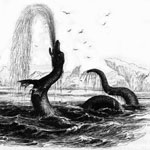National Sea Serpent Day Date in the current year: August 7, 2026
 If you’re a mythology fan, don’t miss your chance to celebrate National Sea Serpent Day on August 7. It commemorates a famous sea serpent sighting by the crew of HMS Daedalus that occurred in August 1868.
If you’re a mythology fan, don’t miss your chance to celebrate National Sea Serpent Day on August 7. It commemorates a famous sea serpent sighting by the crew of HMS Daedalus that occurred in August 1868.Sea serpents, also known as sea dragons, are a type of sea monster widespread in various mythologies. They should not be confused with sea snakes, which are real-life snakes inhabiting marine environments. The majority of adult sea snakes are about 5 feet long, which is hardly monstrous.
Myths depicting a battle where a god or a hero slays a serpent or a dragon can be found in nearly all Indo-European mythologies. This motif is believed to symbolize a clash between chaos and order. In all versions of the story, the serpent is defeated, although in some mythologies the god or the hero ends up dead as well.
Examples of the Drachenkampf (“dragon fight”) mytheme include the victory of Ba’al Hadad over Lotan and the defeat of Tiamat by Marduk in Mesopotamian mythology; the slaying of Leviathan by God in the Hebrew Bible; the battle between Illyuanka and Tarḫunz in Hittite mythology; and the battle between Thor and Jörmungandr during Ragnarök, which neither of them survives.
Ancient Greek mythology had four sea monsters that resemble giant snakes: Cetus (slain by Perseus), Echidna (killed by Argus Panoptes), the Lernaean Hydra (killed by Heracles in the canonical myth), and Scylla (encountered by Odysseus). In some versions of the myth, the Lernaean Hydra and Scylla are the offspring of Echidna.
The names “sea serpent” and “sea dragon” are used interchangeably because dragons were originally envisioned as enormous serpents. The image of a dragon with a pair of wings and two or four legs appeared during the Late Middle Ages, whereas mentions of serpentine monsters, as we’ve already established, can be found in ancient mythologies.
Sightings of sea serpents also have been reported since antiquity. References to reported sightings can be found in Aristotle’s Historia Animalium and Strabo’s Geographica. One of the oldest modern descriptions of a sea serpent was given by Dano-Norwegian missionary Hans Egede. He claimed to have seen a sea monster while sailing past the Greenland coast on July 6, 1734. It is commonly believed that Egede actually saw a giant squid.
One of the most famous reported sea serpent sightings occurred on August 6, 1848. Captain MaQuhae of HMS Daedalus and several of his officers and crew saw a giant sea creature between the Cape of Good Hope and Saint Helena. A report of the sighting was published in The Times and widely debated. The anniversary of this sighting is observed as National Sea Serpent Day, although its unknown creators have got the date slightly confused.
The origins of National Sea Serpent Day are unclear, but it has been celebrated since at least 2009, according to a post published on the blog of the Smithsonian Libraries and Archives. You can observe it by learning more about sea serpents and other sea monsters in various mythologies and spreading the word about the holiday with the hashtag #NationalSeaSerpentDay.
- Category
- Unofficial Holidays
- Country
- USA
- Tags
- National Sea Serpent Day, unofficial holidays, mythological creatures, sea serpents, sea monsters, sea dragons